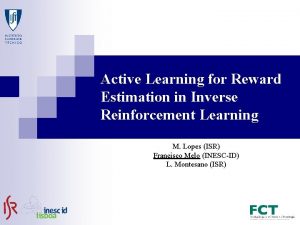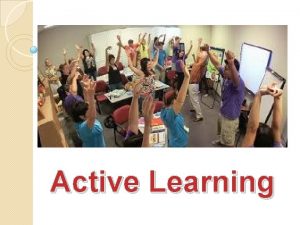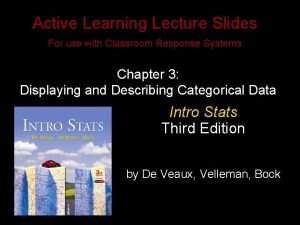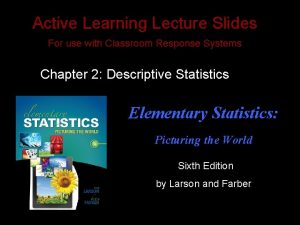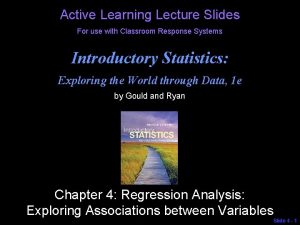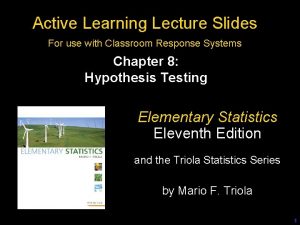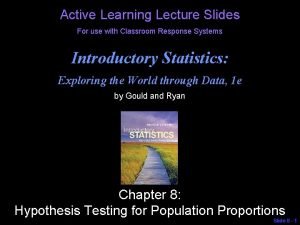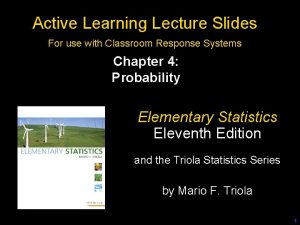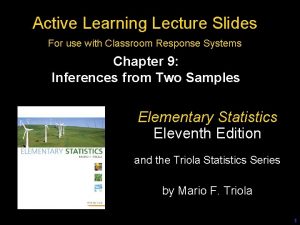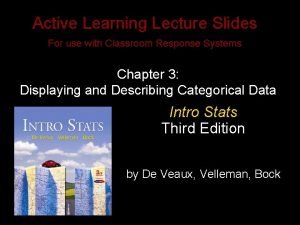Active Learning Lecture Slides For use with Classroom











- Slides: 11

Active Learning Lecture Slides For use with Classroom Response Systems Introductory Statistics: Exploring the World through Data, 1 e by Gould and Ryan Chapter 7. 5 Survey Sampling and Inference © 2013 Pearson Education, Inc. Slide 7 - 1

In most situations in the “real world, ” we know the value of the population proportion A. B. True False Response Counter © 2013 Pearson Education, Inc. Slide 7 - 2

Statistical inference is the art and science of drawing conclusions about a population on the basis of observing only a small subset of that population. A. B. True False Response Counter © 2013 Pearson Education, Inc. Slide 7 - 3

A confidence interval provides a range of plausible values for a population parameter. A. B. True False Response Counter © 2013 Pearson Education, Inc. Slide 7 - 4

A confidence interval is often reported as an estimate plus or minus some amount. This “some amount” is called A. B. C. D. Confidence level Capture rate Margin of error Standard error Response Counter © 2013 Pearson Education, Inc. Slide 7 - 5

The confidence level measures A. B. C. D. The probability of the parameter being contained in the interval How often the estimation method is successful The probability of a statistic being contained in the interval. All of the above. Response Counter © 2013 Pearson Education, Inc. Slide 7 - 6

True or False The confidence level measures the capture rate for our method of finding confidence intervals. A. B. True False Response Counter © 2013 Pearson Education, Inc. Slide 7 - 7

True or False It is correct to say that a particular confidence interval has a 95% (or any other percent) chance of including the true population parameter. A. B. True False Response Counter © 2013 Pearson Education, Inc. Slide 7 - 8

True or False It is correct to say that the process that produces intervals captures the true population parameter with a 95% probability. A. B. True False Response Counter © 2013 Pearson Education, Inc. Slide 7 - 9

To obtain a 95% confidence level, we use a margin of error of A. B. C. D. 2. 58 standard errors 1. 96 standard errors 1. 645 standard errors 1. 28 standard errors Response Counter © 2013 Pearson Education, Inc. Slide 7 - 10

In the 1960 presidential election, 34, 226, 731 people voted for Kennedy; 34, 108, 157 for Nixon, and 197, 029 for thirdparty candidates. Would it be appropriate to find a confidence interval for the proportion of voters choosing Kennedy? A. B. Yes, simple find the standard error and add/subtract 1. 96 times the standard error to the estimate. No, we already know the population proportion. We only need a confidence interval when we have a sample proportion and want to generalize about the population. Response Counter © 2013 Pearson Education, Inc. Slide 7 - 11
 Introduction to machine learning ethem alpaydın
Introduction to machine learning ethem alpaydın A small child slides down the four frictionless slides
A small child slides down the four frictionless slides Robert pushes the box to the left
Robert pushes the box to the left Principles of economics powerpoint lecture slides
Principles of economics powerpoint lecture slides Business communication lecture slides
Business communication lecture slides 01:640:244 lecture notes - lecture 15: plat, idah, farad
01:640:244 lecture notes - lecture 15: plat, idah, farad Passive learning vs active learning
Passive learning vs active learning Inverse reinforcement learning
Inverse reinforcement learning Btech smart classes
Btech smart classes Cuadro comparativo de e-learning b-learning y m-learning
Cuadro comparativo de e-learning b-learning y m-learning And or boolean
And or boolean Membrane structures that function in active transport
Membrane structures that function in active transport







